LED Technology Advancements that have Revolutionized the Lighting Industry!
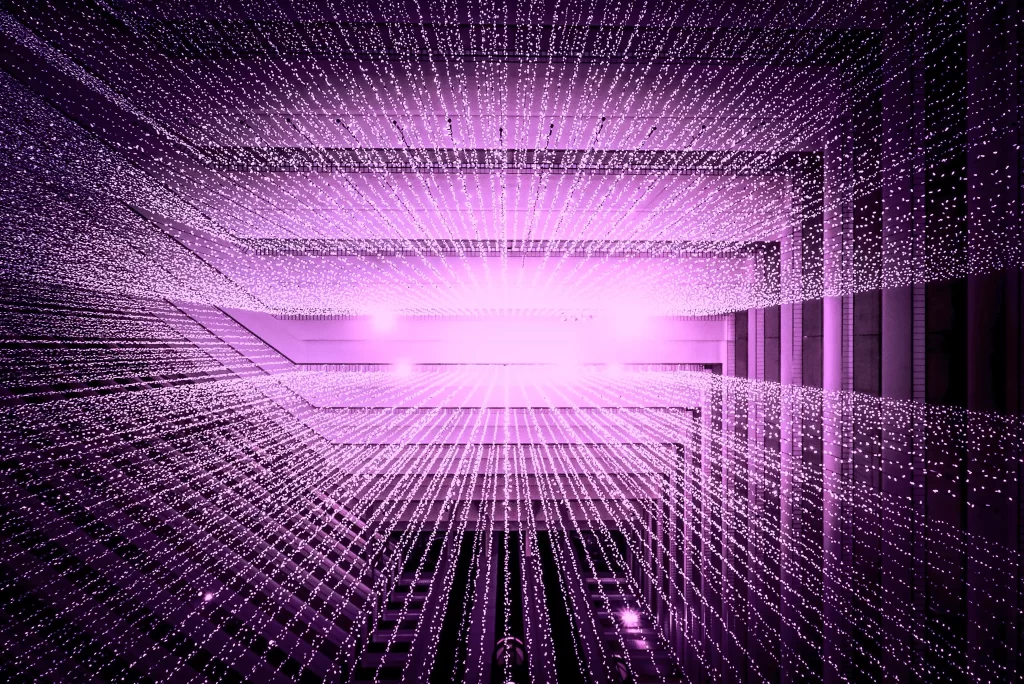
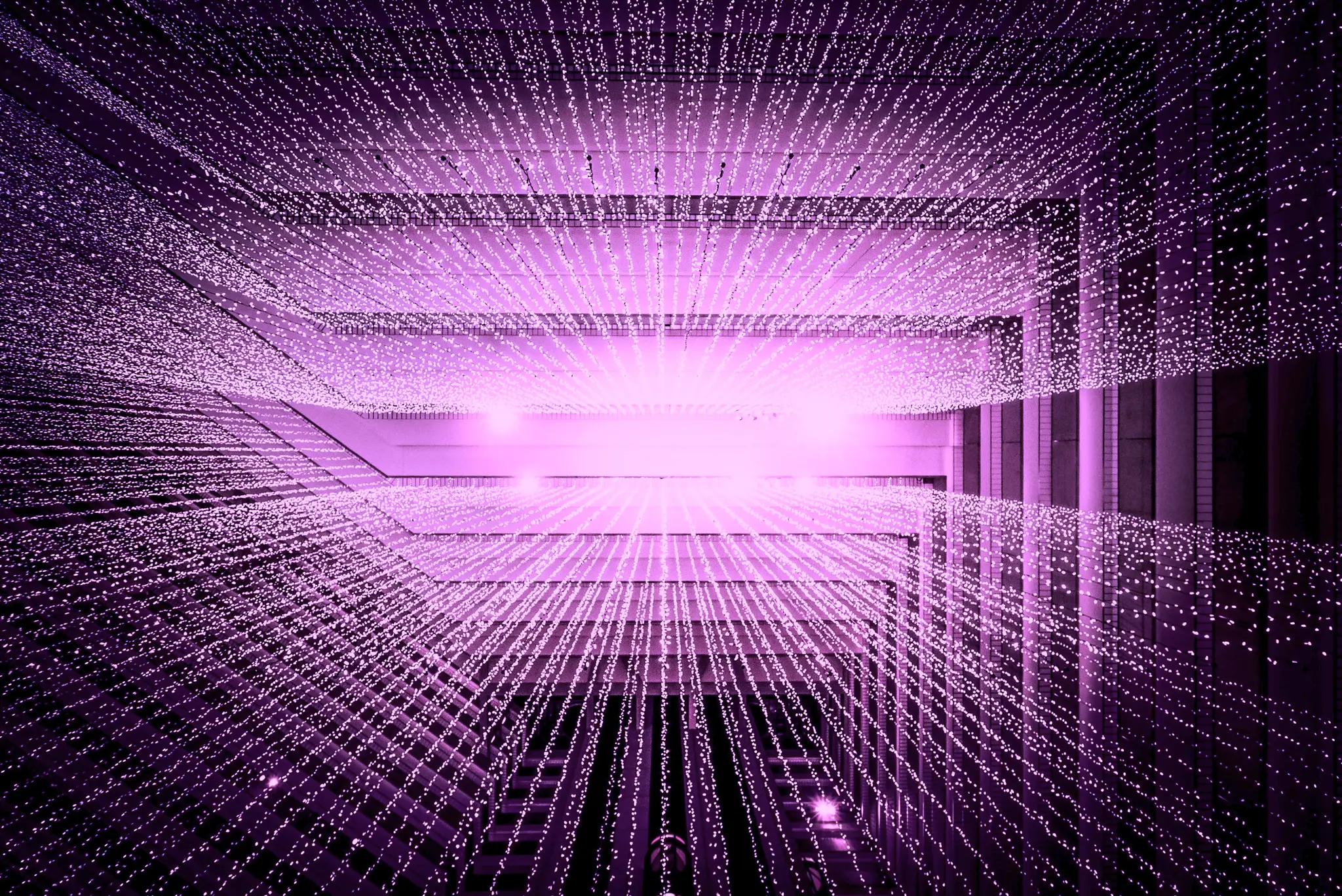
Photo by Joshua Sortino from Unsplash
The lighting industry has been buzzing with news of solid-state light source advancements for several years. As one light-emitting diode (LED) lighting fixture manufacturer puts it, flat printed circuit boards versus bulbous or tubular linear sources open up a whole new world of design possibilities. Now, the LED and its sister technology, the organic light-emitting diode (OLED) two light sources that constitute solid-state lighting — have the potential to replace many light sources that either heat a tungsten filament to incandescence or use a pair of filaments within a glass envelope to create an ionized arc stream.
The photo below is from Dubai’s financial district using LED lights to brighten their architecture bringing stunning new looks and designs to the city (JUMANA ABDEL-RAZZAQ).
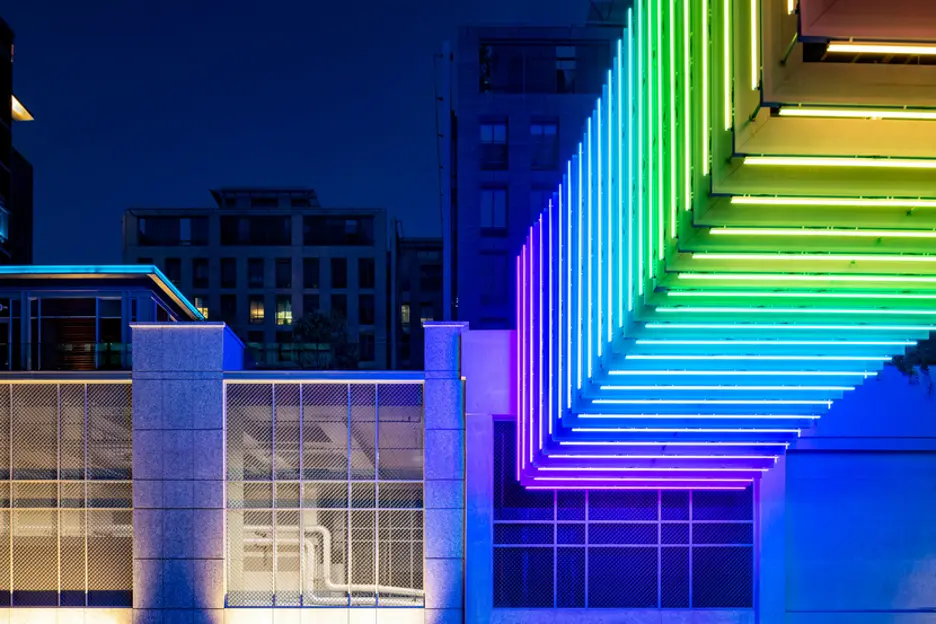
Over the years, these tiny diodes have improved in color range, lumen output, color stability, lifespan, and other performance factors, allowing LEDs to encroach on, and dominate, many niche lighting markets from indicator lights and traffic signals to exit signs and decorative architectural lighting.
Because a single LED is comparatively small, it can be assembled into an array of dozens or even hundreds of dies on a panel or a strip. Therefore, an LED “fixture” can be any size or shape. As a result, solid-state lighting has the potential to reduce complexity in the selection, design, and installation of lighting fixtures. Traditional and newly emerging lighting fixture manufacturers are actively studying applications in which LEDs are suitable and then working backward to develop fixtures that can be easily mounted, effectively maintained, and economically controlled.
For suppliers striving to introduce LED lighting into the general illumination market, the biggest challenge is to provide high lumen output from dies that produce white light. For electrical engineers and installing electrical contractors, the challenge is to learn more about this technology so that they can specify and install high-quality, specification-grade products to the satisfaction of demanding clients.
At present, virtually no standards for measuring, reporting, testing, or applying LEDs exist, but overly optimistic or irrelevant claims about these emerging LED products could severely curtail market acceptance. Fortunately, many organizations, believing that LEDs offer tremendous market potential, are cooperating in standards development.
For example, the Illuminating Engineering Society of North America (IESNA) and the Next Generation Lighting Industry Alliance (NGLIA) are working with the U.S. Department of Energy (DOE) Building Technologies Program to achieve a number of goals, including developing procedures for photometric measurements of LEDs, laser diodes, organic LEDs, and any other semiconductor light sources of the future.
In 2007, Underwriters Laboratories Inc. (UL) will publish UL 8750, “Outline of Investigation (OOI) for LED Light Sources for Use in Lighting Products.” When released, this OOI will be applied in any investigation of the LED light sources used in UL-listed lighting products. According to UL, in terms of fire risk, the temperature rise exhibited by LED systems might bring them close to the limit of 90°C — the maximum temperature permitted on surfaces under the building codes within the U.S.
Because LED products can take on a variety of sizes and shapes, they offer tremendous opportunities for innovative lighting solutions in both interior and exterior lighting design. Rather than distributing light from a single, bright source within a fixture, LEDs can place light across a surface or deliver it in multiple planes. They can be integrated into architectural materials, such as concrete, and they can edge light glass or plastic panels.
Here is an example of LED lighting innovation in Tom Hegen’s Greenhouse Series of agriculture greenhouse LED lighting research that explores the evolution of what agricultural lighting and cityscapes will look like as technology advances to solve growing uses around food production in an ever-expanding world.
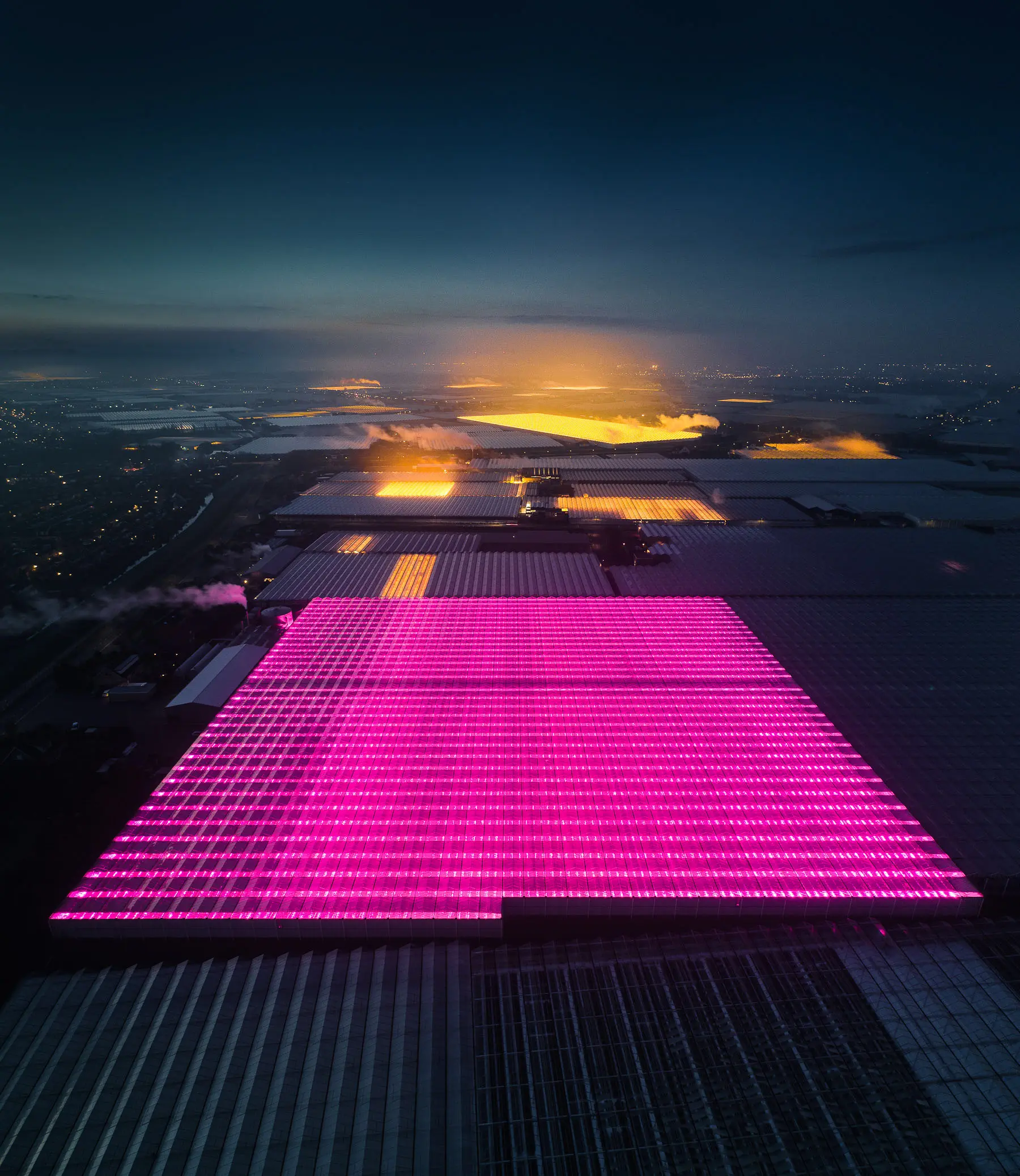
Rugged and void of catastrophic failure, solid-state lighting devices can operate on low-voltage DC power or directly on AC power. They can start instantly at temperatures as low as -40°C, and are easily dimmed and controlled without any distracting flicker. The absence of infrared and ultraviolet energy radiation makes LEDs attractive in many applications. Moreover, they are environmentally friendly, meeting new ecological regulations that ban mercury and lead from the waste disposal stream.
In an effort to boost solid-state lighting use, the DOE is extending its Energy Star program to LED-based luminaires. Energy Star is a voluntary labeling program designed to identify and promote energy-efficient products. This draft document defines eight designated correlated color temperatures (CCT) values. The LEDs must have a useful life of 35,000 hours based on average rated lumen maintenance of at least 70% of initial device lumens. Also included are definitions of color spatial uniformity and color maintenance over lifetime, as well as driver, packaging, and warranty requirements for luminaires.
Outdoor lighting may be the first general illumination application to gain a foothold — and for specific economic reasons. One light source manufacturer has developed an LED street light with a “light engine” having an output of 80 lumens per watt. Considering the expense of relamping a typical street light using an HID lamp with a typical life of 15,000 to 25,000 hours, the mean time to lamp replacement could be greater than three times that life. Thus, the added initial cost of the LED luminaire is recovered over time in a reduction of lamp maintenance expenses.
As government regulations continue to restrict the use of less efficient light sources, LED technology development will continue to thrive.
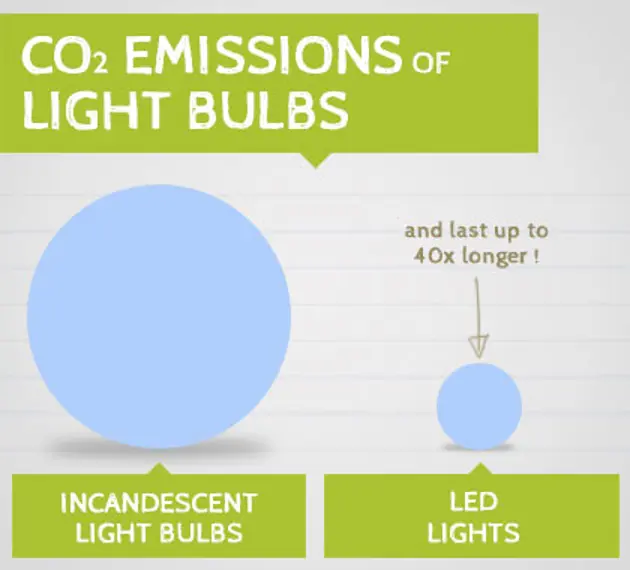
Not only are design developments in LEDs significant but how LED tech has shaped our lives in even bigger ways, according to Goldman Sachs LED Industry Report, “the accelerated deployment of light-emitting diode (LED) bulbs is on track to save U.S. consumers and businesses $20 billion a year in electricity costs within a decade, which would lower U.S. CO2 emissions by some 100 million metric tons a year! The growing global effort to speed up LED tech adoption could ultimately cut global energy costs and carbon pollution 5 times as much.”
Investing in quality LED lights for homes is a major money saver, saving money on the electric bill whether it’s for homes or business. With a simple switch of a lightbulb, it’s also saving the earth. LEDs use a fraction of the energy costs making it cost efficient, especially with big offices and those with apartments looking to cut down on their energy costs. Nowadays energy bills are a very big expense and lighting composes 15% of it.
With the many different sizes, LEDs are very adaptable and can fit almost anything. With the coming years many individuals have been more aware of the state of our earth and global warming, causing a consumer switch to eco-conservation products. With the manufacturing of LEDs and the cost becoming more affordable, it’s easy for consumers to switch and for corporations to invest in developing LED technology. With the quick and mass adoption of LED’s resulting in massive positive effects, who’s to say there won’t be a continuation of major developments in the LED lighting category in the future?
The picture below shows the price of LEDs dropping around 90% in the past couple of years, making the adoption of LED lights in business and households more accessible. With the continued drop in price, LEDs will soon become the leader in modern day lighting. With the ability to increase lumens which is the amount of light produced they were also able to lengthen their longevity, making their costs go down. It is actually predicted that the price of LEDs will continue to drop while the quality of life and light will continue to increase exponentially.
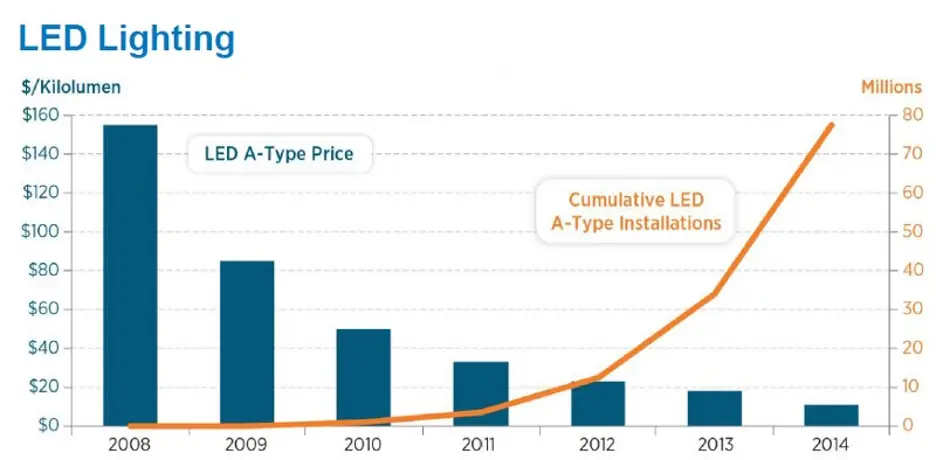
With the long lasting capability of LEDs it’s understandable why people have continued to switch from other types. Not only is the long life great for homes and business, it is also great for safety reasons. Flashlights using LEDs will tend to last longer, making them great for situations where long lasting light is a necessity. Many first responders choose LED’s for their lighting for emergency situations, in dangerous events LEDs are the light of choice because of the proven strength and longevity. Of course it hasn’t always been this way, because of LEDs known success its the first choice for first responders. This is just one of the many ways that LEDs have evolved, they have impacted the efficiency of first responders and aided them in doing their jobs, whether it’s lights for their vehicles, lights on their helmets, flashlights. LEDs are deeply integrated in most of their systems.
In the healthcare field LEDs are also being used. For example in pulse OX monitors where they use LED as a transmission to measure both heart rate and oxygen saturation. Not only have LEDs made their way into the healthcare system but there is ongoing research into using LED for other life saving systems. Surprisingly there are still a lot of humans out there that don’t have access to clean drinking water. With new research LEDs could possibly be used to help in the process of water purification. The ongoing research is into having LED based portable water purification systems that are great for point of use. LEDs are also being used in places where there are no reliable sources of light. Promotion of portable solar powered LEDs with high brightness, to be used in these places.
LEDs have been leading the world to a better and safer place, by not only being the smartest choice for lighting in homes and businesses, but also lighting for first responders, hospitals, and health care innovations!
Not to mention, the development of LEDs for those in need. LEDs have grown tremendously in the past few years but will only continue to grow, reducing carbon emissions on the way. Soon enough LEDs will replace all of the lights we have, in our businesses on the streets, and more. Investing in LED lights for your homes or business can improve mood and production as well. With the development in LEDs they have had the ability to impact lives on a level lighting has never been before. The continuation of LED innovation and development across all industries health, architectural, agricultural, and more will light the way to the future . With the continued research it is possible that LED lights will replace all other forms of lighting that we have, and possibly lead to new findings in how LEDs can be used to help those in need as well.
Sources:
https://www.ecmweb.com/lighting-control/article/20890827/the-evolution-of-the-led
https://archive.thinkprogress.org/5-charts-that-illustrate-the-remarkable-led-lighting-revolution-83ecb6c1f472/
https://www.apo-tokyo.org/publications/wp-content/uploads/sites/5/2012_Sep-Oct_p4-5.pdf
https://www.accessscience.com/content/the-bright-future-of-led-lighting/BR0715151
https://www.lightday.org/development
https://www.behance.net/gallery/86574881/The-Greenhouse-Series